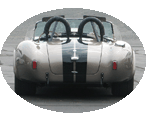
09-01-2009, 11:26 AM
|
 |
Half-Ass Member

|
|
|
Join Date: Jun 2005
Cobra Make, Engine: ERA #732, 428FE (447 CID), TKO600, Solid Flat Tappet Cam, Tons of Aluminum
Posts: 22,017
|
|

 Not Ranked
Not Ranked

Quote:
Originally Posted by RAO-3

Thanks Patrick ... it was you and Rick Lake ... that helped me to understand this was the right direction to go for a street car and not to 'overbuild' the engine.
|
Rick is actually my evil twin.  Sooner or later somebody will ask you about the ribs on the side of your block. There are two competing views on the origins of the ribs. Here are two quotes that I ripped from the FE Forum that summarize them succinctly. Both are from the same author (a well respected FE expert).
Quote:
Dave Shoe --- One suspicion I have is...
...that when the MCC (Michigan Casting Center) was opened in 1971-1972, it was equipped for thinwall casting technology. I don't believe DIF was so equipped. I do have some info from TRW which suggests 1972-later FE blocks may use thinwall technology. Incidentally, I believe DIF closed down shortly after MCC came on line. I am also curious as to whether CF cast any FE blocks, as that place seems to have used thinwall technology (preheating of cores, a more ductile alloy, and thinner wall sections), but the FE molds at the time were likely still thickwall in design. Anyhow, the MCC blocks would likely be 1/32" thinner due to the use of preheated sand cores and a more ductile type of iron (I don't yet know if it was a full-nodular). I'm sorta wondering whether the stripes helped prevent "chilling" (a too-rapid cooling) in the extra-thin iron (chilling causes molten carbon to form unmachinable and brittle fast-forming carbides rather than slow-forming ductile graphite flakes or spheroids). Chilling is desirable in certain iron products when a brittle, wear resistant surface is needed to make the part work. Many cast iron products actually design thin sections of the casting so they can become chilled, and other sections of the casting thicker so they solidify more slowly and thus become either machinable and/or ductile sections, depending on what characteristic is desired. This makes some sense to the early 427 ribs, as the 427 would need ductile skirts because the crossbolts stressed the skirt, whereas the regular FEs in 1968 could deal with slightly-"chilled" skirts, because the stiffening loads were distributed more gradually across them. One thin I'm gonna have to do is weigh my DIF, CF, and MCC castings to see whether castings from some foundries are characteristically lighter in weight.
Shoe.
P.S.: Please copy down any other symbols or numbers you see (except for the boring clock symbol). It's nice to gather this info, just for the heck of it. In particular, I'm starting to notice the "E" and "W" stamps more, wondering if it has something to do with "East" and "West" or something.
|
================================================== =========================
Quote:
Dave Shoe --- Rumor of warn tooling is false.
The worn-out tooling rumor simply has no merit. There is no economy in it, and tooling wears out by thickening the walls and flashing over, not thinning the walls. The FE was retasked from being a grocery getter to being a faithful workhorse in 1971. The external ribs started showing up around the time the FE became a truck only engine. Even the few 1971 Galaxies that got a 390 got the low-compression pickup-truck version of the FE. Note that FEs often got internal "water jacket" ribs that looked just the same as the outside ones, so ribbing was nothing new to the FE block. Just the placement was varied. I suspect the ribs were eventually moved to the outside of the block to strengthen water jacket sand cores, since internal ribs created thin segments in water jacket sand cores that might cause them to warp or crack when the metal was poured into the mold. As the 1970s progressed, more and more blocks got the ribs. I have not seen much correlation between performance and plain engines, particularly since performance FEs were not a new-engine product when the ribs arrived. Another FE performance enhancement of the 1970s was increasing use of nodular iron maincaps. Also, all blocks cast at the new MCC foundry (a.k.a.: 105 blocks) got reinforced bulkhead webbing, even if they usually got plain 360/390 water jackets.
Shoe.
|
|